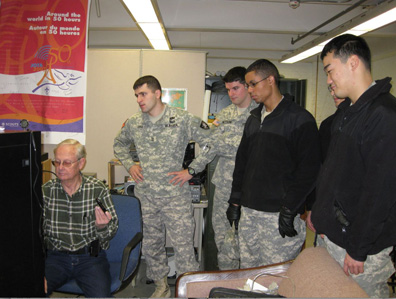
Attached photo: Mr. John Clark, Air Force Academy Department of Astronautics, trains West Point cadets in the operations of the new electronics suite, which will allow West Point cadets to communicate with the Air Force Academy’s FalconSAT-3.
FalconSAT-3 is one of two Air Force Academy satellites currently in orbit, conducting scientific experiments. This cadet-built and cadet-designed satellite was launched March 8, 2007, and is operated by the Air Force Academy’s ground control station.
Now the U.S. Military Academy has joined that team with their new ground control station. “Friday was the first day they received a signal from FalconSAT-3 seen at their ground control station. They are really the third ground control station for FalconSAT-3, after us and the Air Force Institute of Technology,” said Astronautics professor Bill Saylor, Schriever Chair at the Air Force Academy and a 1972 West Point graduate. The satellite was under joint control at that time. Air Force Academy cadets were teleconferenced with West Point, and commanded FalconSAT-3 to broadcast a signal while passing over West Point.
Cadets from West Point’s Small Satellite Research Group and Ham Radio Club staffed the ground control station and successfully received the signal. The amateur radio club, which dates back to 1909, has already demonstrated the capability to monitor to track some satellites in orbit. That capability went up a notch after Mr. John Clark from the Air Force Academy’s Department of Astronautics oversaw the installation of the FalconSAT-3 electronics suite in West Point’s Bartlett Hall. For West Point, this puts them a step closer to launching their own small satellite program. For USAFA, the immediate goal going forward is to initially finish commissioning the West Point ground control station.
“From USAFA, we can get three to four passes per day due to orbital mechanics,” said Jack Anthony, chief of operations of the Air Force Academy’s Small Satellite Research Center and a 1978 Air Force Academy graduate. “But with West Point’s ground station, we can get seven or maybe eight passes a day to communicate with FalconSAT-3.”
This milestone paves the way for future joint operations of research satellites and West Point’s work on its small satellite program, said Professor Saylor.
FalconSAT-3 is part of the Air Force Academy’s current space fleet. This research satellite has several scientific experiments in its payload, including:
- Flat Plasma Spectrometer: which characterizes the effects of non-Maxwellian charged particles on the formation, propagation and decay of ionospheric plasma bubbles. These space weather effects can impact space-based communication and navigation signals, including the Global Positioning System and other civil and military communications.
- Plasma Local Anomalous Noise Element: which identifies and characterizes spacecraft-induced plasma turbulence.
- Micropropulsion Attitude Control System: a low-thrust, electricpulsed plasma system with a thrust of 150 micro-Newtons, established the space flight heritage for this new technology.
Meanwhile, work is underway on the first model of FalconSAT-6. The main experiment aboard FalconSAT-6 is a multi-mode flight experiment designed to prove the effectiveness of multiple thrust modes. Several other experiments will also be carried, and among these are experiments designed to prove and provide the most fuel-efficient changes in orbit which are available, and to test low energy ion head thrusters, testing the effectiveness of wireless versus wired telemetry, and measuring changes to the local ionospheric environment.
The structural engineering model of FalconSAT-6 will be completed this semester, which will complete the first year of the three years it takes to bring a FalconSAT satellite from drawing board to delivery for launch. FalconSAT-6 will be delivered to the launch provider in 2013 for a launch in the fall of that year.

